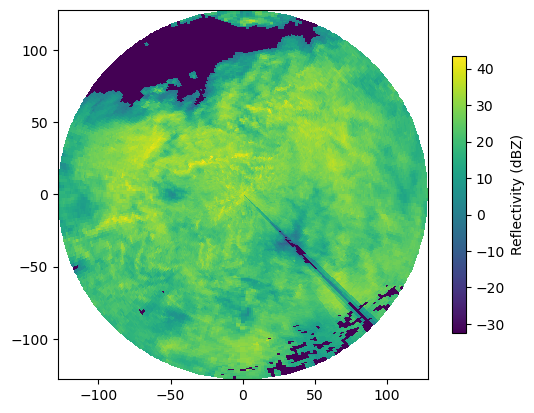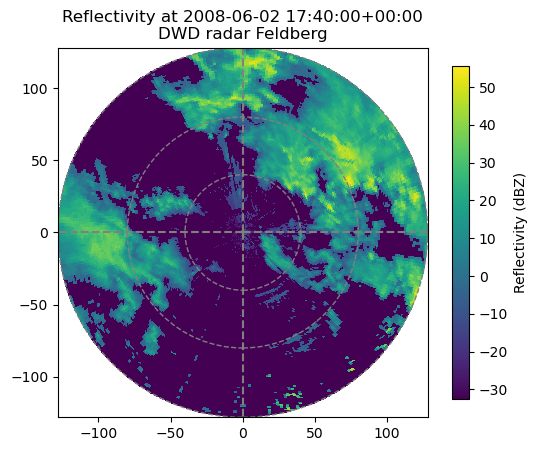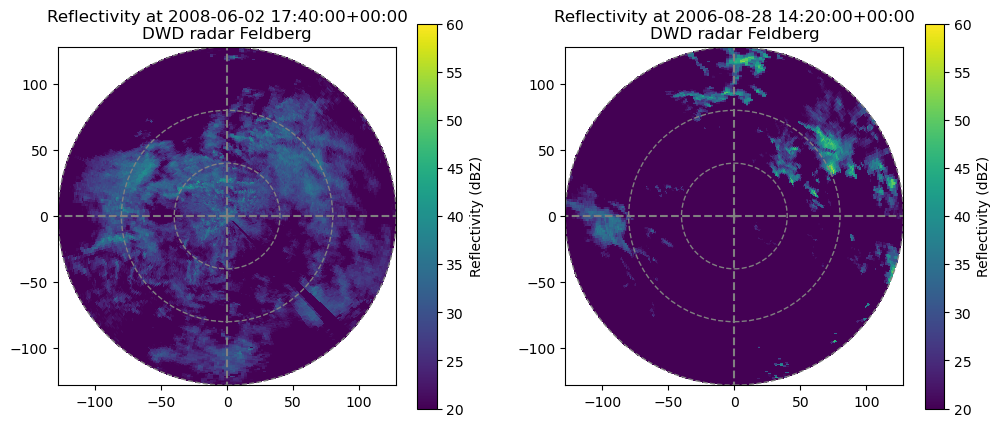Handling DX Radar Data (German Weather Service)#
This tutorial helps you to read and plot the raw polar radar data provided by German Weather Service (DWD).
Reading DX-Data#
The German weather service provides polar radar data in the so called DX format. These have to be unpacked and transfered into an array of 360 (azimuthal resolution of 1 degree) by 128 (range resolution of 1 km).
The naming convention for DX data is:
raa00-dx_<location-id>-<YYMMDDHHMM>-<location-abreviation>---bin
or
raa00-dx_<location-id>-<YYYYMMDDHHMM>-<location-abreviation>---bin
For example: raa00-dx_10908-200608281420-fbg---bin raw data from radar station Feldberg (fbg, 10908) from 2006-08-28 14:20:00.
Each DX file also contains additional information like the elevation angle for each beam. Note, however, that the format is not “self-describing”.
Raw data for one time step#
Suppose we want to read a radar-scan for a defined time step. You need to make sure that the data file is given with the correct path to the file. The read_dx function returns two variables: the reflectivity array, and a dictionary of metadata attributes.
[2]:
filename = wrl.util.get_wradlib_data_file("dx/raa00-dx_10908-200608281420-fbg---bin.gz")
one_scan, attributes = wrl.io.read_dx(filename)
print(one_scan.shape)
print(attributes.keys())
print(attributes["radarid"])
Downloading file 'dx/raa00-dx_10908-200608281420-fbg---bin.gz' from 'https://github.com/wradlib/wradlib-data/raw/pooch/data/dx/raa00-dx_10908-200608281420-fbg---bin.gz' to '/home/runner/work/wradlib/wradlib/wradlib-data'.
(360, 128)
dict_keys(['producttype', 'datetime', 'radarid', 'bytes', 'version', 'cluttermap', 'dopplerfilter', 'statfilter', 'elevprofile', 'message', 'elev', 'azim', 'clutter'])
10908
Raw data for multiple time steps#
To read multiple scans into one array, you should create an empty array with the shape of the desired dimensions. In this example, the dataset contains 2 timesteps of 360 by 128 values. Note that we simply catch the metadata dictionary in a dummy variable:
[3]:
import numpy as np
two_scans = np.empty((2, 360, 128))
metadata = [[], []]
filename = wrl.util.get_wradlib_data_file("dx/raa00-dx_10908-0806021740-fbg---bin.gz")
two_scans[0], metadata[0] = wrl.io.read_dx(filename)
filename = wrl.util.get_wradlib_data_file("dx/raa00-dx_10908-0806021745-fbg---bin.gz")
two_scans[1], metadata[1] = wrl.io.read_dx(filename)
print(two_scans.shape)
(2, 360, 128)
Visualizing dBZ values#
Now we want to create a quick diagnostic PPI plot of reflectivity in a polar coordiate system:
[4]:
pl.figure(figsize=(10, 8))
ax, pm = wrl.vis.plot_ppi(one_scan)
# add a colorbar with label
cbar = pl.colorbar(pm, shrink=0.75)
cbar.set_label("Reflectivity (dBZ)")
<Figure size 1000x800 with 0 Axes>

This is a stratiform event. Apparently, the radar system has already masked the foothills of the Alps as clutter. The spike in the south-western sector is caused by a broadcasting tower nearby the radar antenna.
Another case shows a convective situation:
[5]:
pl.figure(figsize=(10, 8))
ax, pm = wrl.vis.plot_ppi(two_scans[0])
cbar = pl.colorbar(pm, shrink=0.75)
cbar.set_label("Reflectivity (dBZ)")
<Figure size 1000x800 with 0 Axes>

You can also modify or decorate the image further, e.g. add a cross-hair, a title, use a different colormap, or zoom in:
[6]:
pl.figure(figsize=(10, 8))
# Plot PPI,
ax, pm = wrl.vis.plot_ppi(two_scans[0], cmap="viridis")
# add crosshair,
ax = wrl.vis.plot_ppi_crosshair((0, 0, 0), ranges=[40, 80, 128])
# add colorbar,
cbar = pl.colorbar(pm, shrink=0.9)
cbar.set_label("Reflectivity (dBZ)")
# add title,
pl.title("Reflectivity at {0}\nDWD radar Feldberg".format(metadata[0]["datetime"]))
# and zoom in.
pl.xlim((-128, 128))
pl.ylim((-128, 128))
[6]:
(-128.0, 128.0)
<Figure size 1000x800 with 0 Axes>

In addition, you might want to tweak the colorscale to allow for better comparison of different images:
[7]:
fig = pl.figure(figsize=(12, 10))
# Add first subplot (stratiform)
ax = pl.subplot(121, aspect="equal")
# Plot PPI,
ax, pm = wrl.vis.plot_ppi(one_scan, cmap="viridis", ax=ax, vmin=20, vmax=60)
# add crosshair,
ax = wrl.vis.plot_ppi_crosshair((0, 0, 0), ranges=[40, 80, 128])
# add colorbar,
cbar = pl.colorbar(pm, shrink=0.5)
cbar.set_label("Reflectivity (dBZ)")
# add title,
pl.title("Reflectivity at {0}\nDWD radar Feldberg".format(metadata[0]["datetime"]))
# and zoom in.
pl.xlim((-128, 128))
pl.ylim((-128, 128))
# Add second subplot (convective)
ax = pl.subplot(122, aspect="equal")
# Plot PPI,
ax, pm = wrl.vis.plot_ppi(two_scans[0], cmap="viridis", ax=ax, vmin=20, vmax=60)
# add crosshair,
ax = wrl.vis.plot_ppi_crosshair((0, 0, 0), ranges=[40, 80, 128])
# add colorbar,
cbar = pl.colorbar(pm, shrink=0.5)
cbar.set_label("Reflectivity (dBZ)")
# add title,
pl.title("Reflectivity at {0}\nDWD radar Feldberg".format(attributes["datetime"]))
# and zoom in.
pl.xlim((-128, 128))
pl.ylim((-128, 128))
[7]:
(-128.0, 128.0)

The radar data was kindly provided by the German Weather Service.
